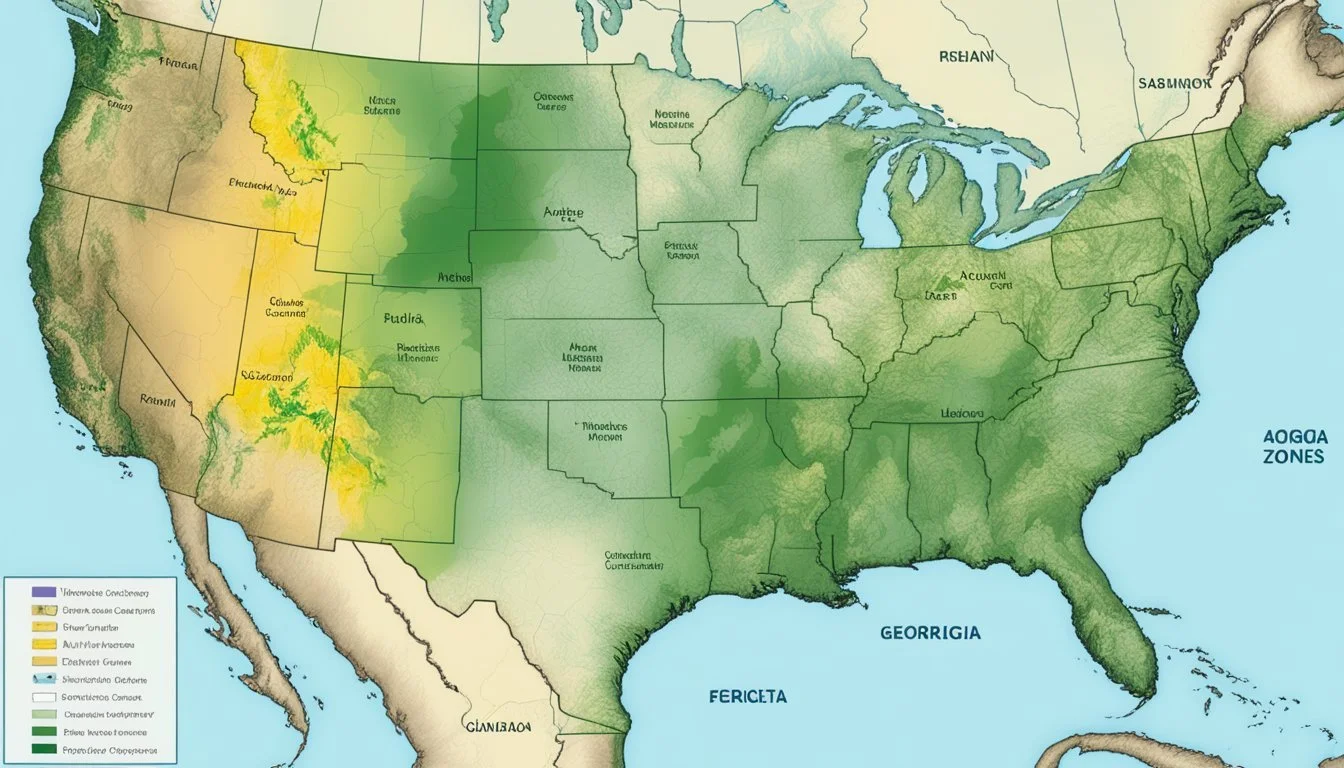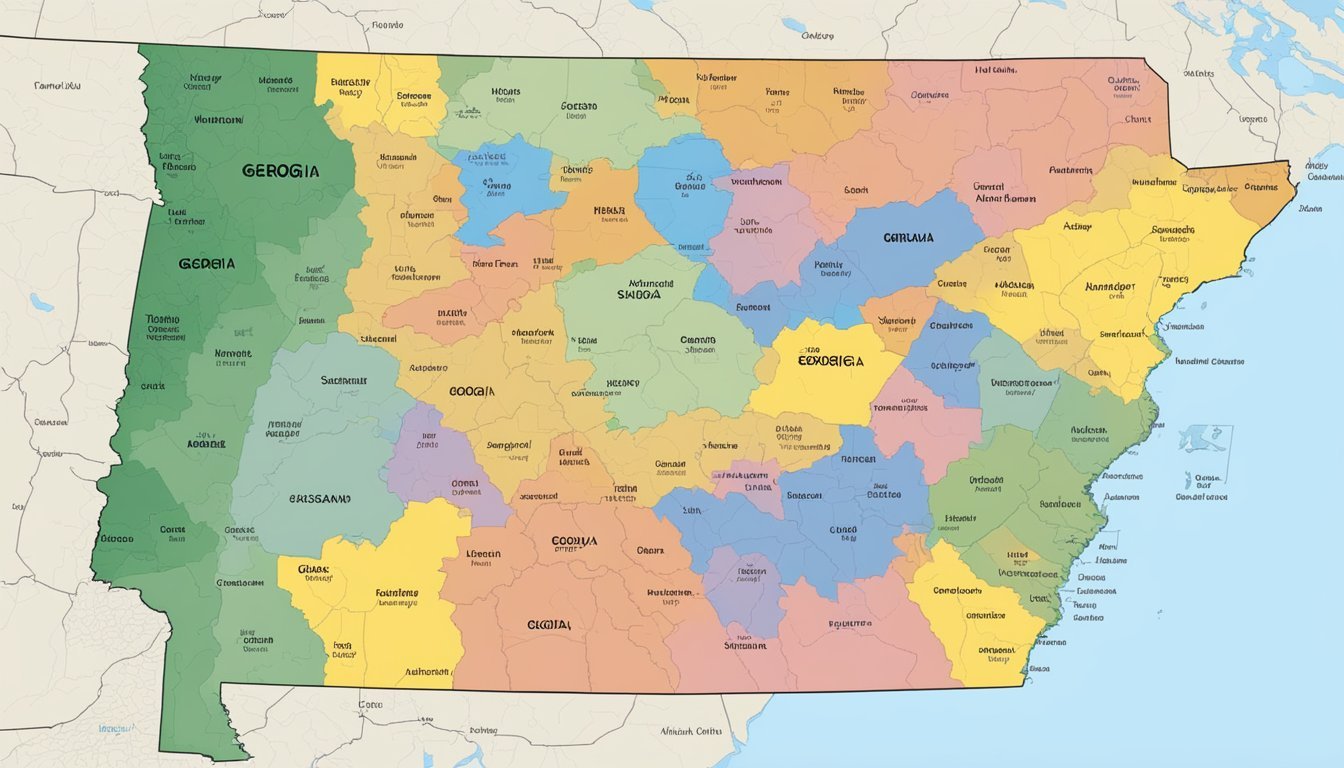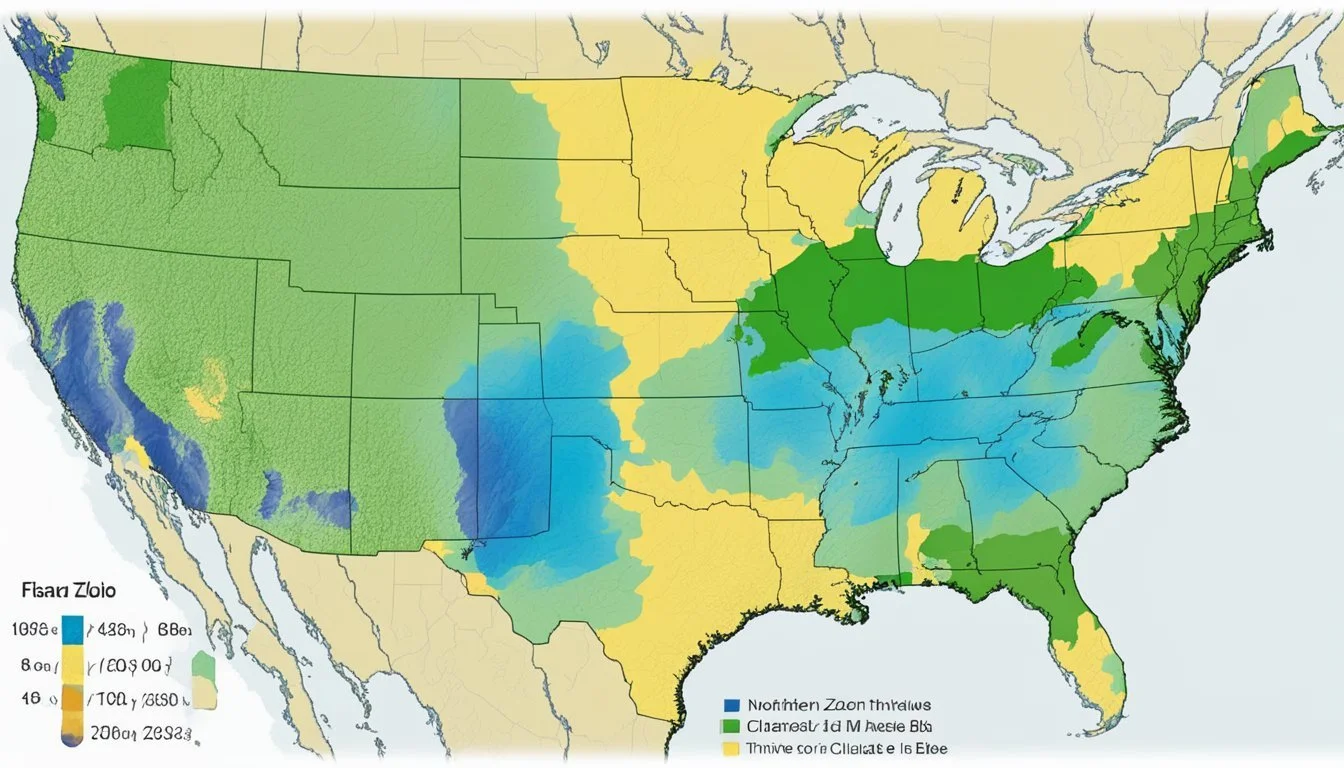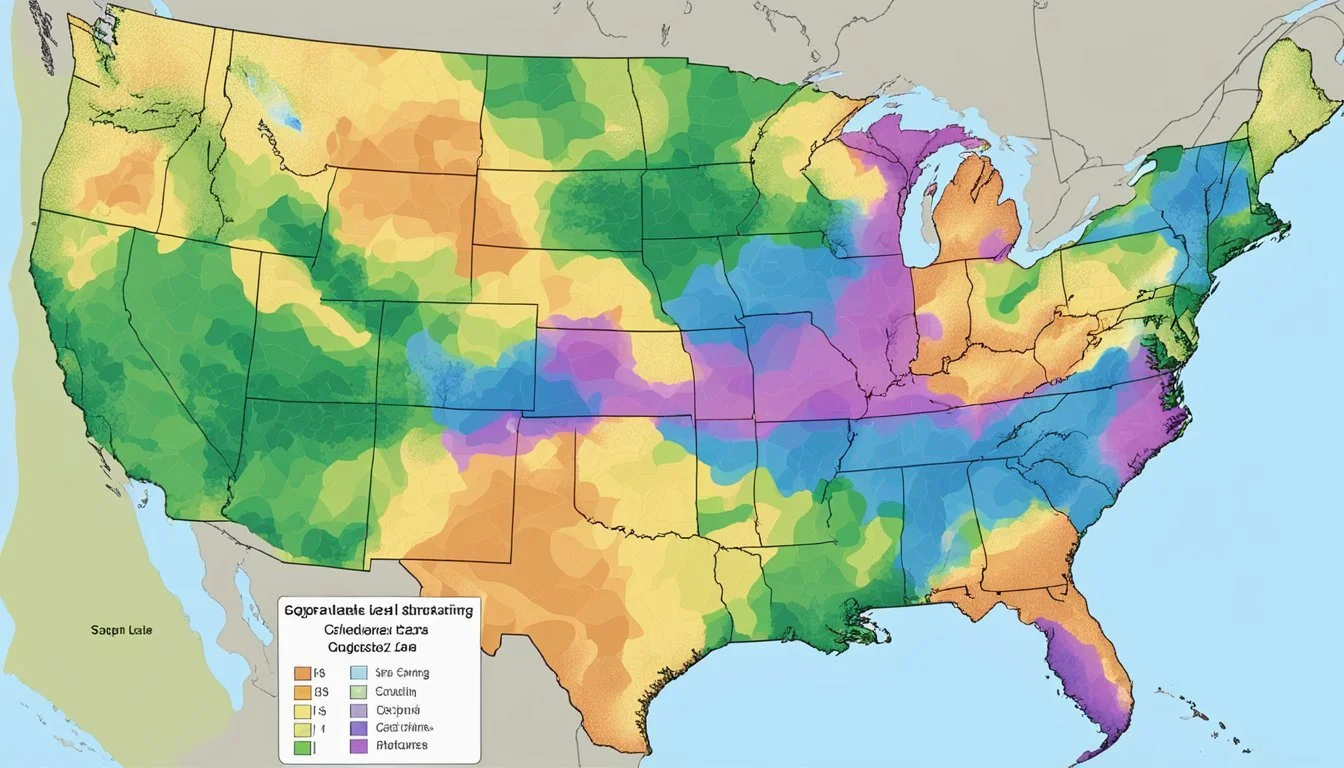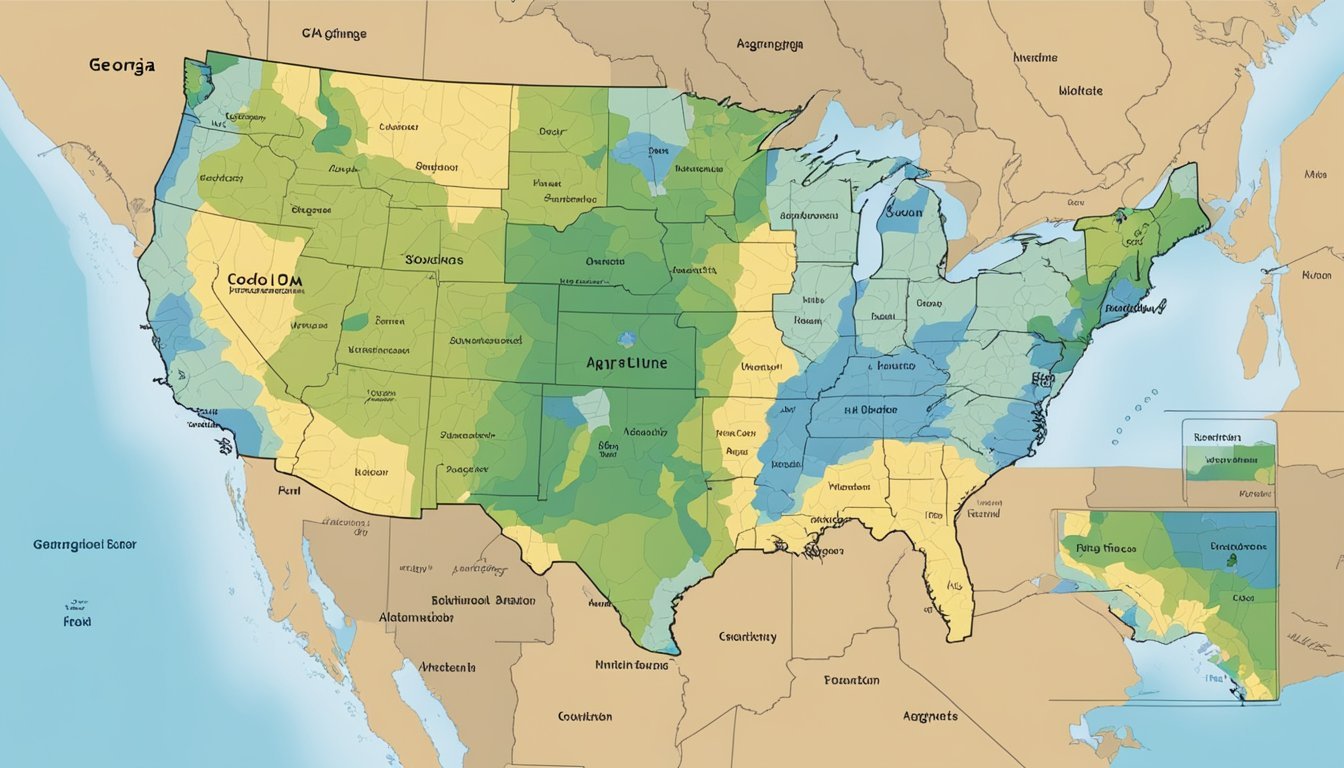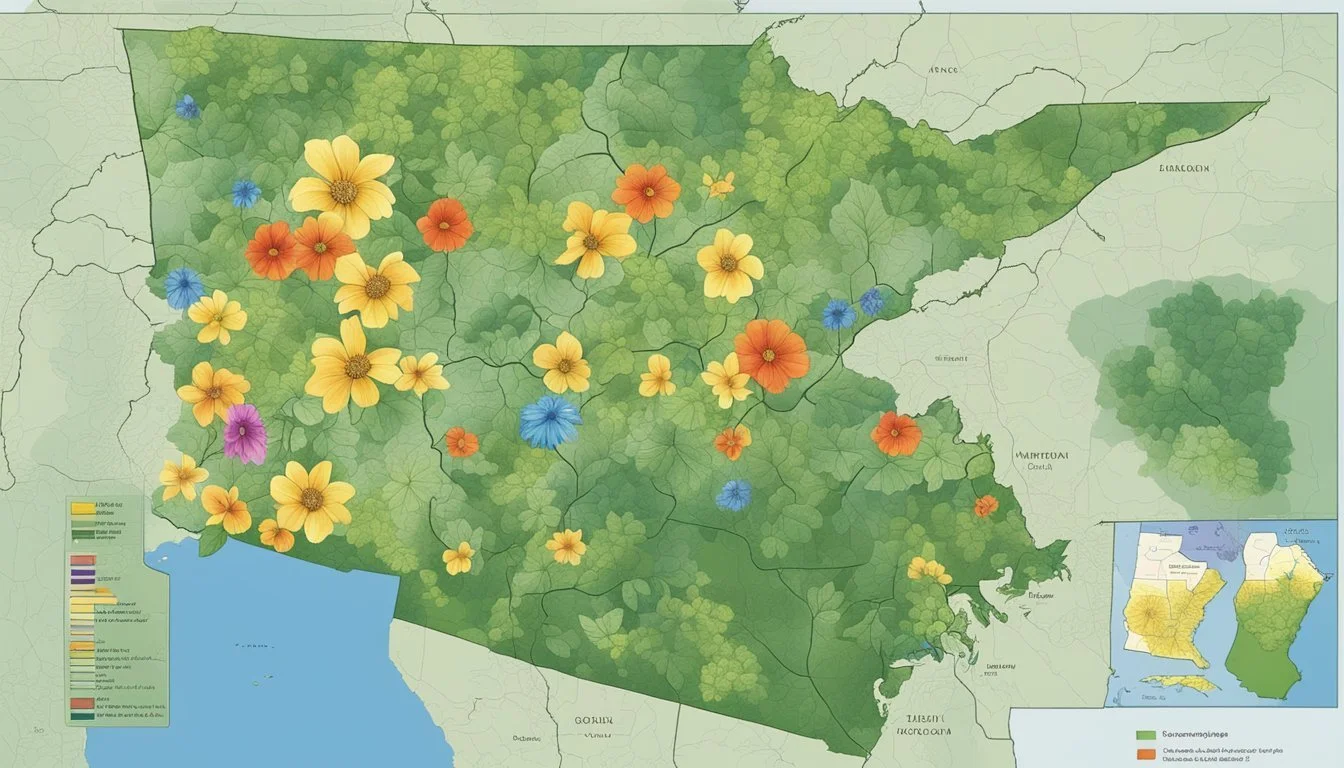USDA Hardiness Zones in Georgia
Navigating the Peach State's Planting Map
Understanding the USDA Hardiness Zones is essential for gardeners and farmers in Georgia. These zones serve as a guide for determining the types of plants that can thrive in a particular location, based on the average annual extreme minimum temperature. Gardeners in Georgia can reference the 2023 USDA Plant Hardiness Zone Map to gain insights into which perennial plants are likely to succeed in their gardens and landscapes.
The state of Georgia spans multiple hardiness zones, reflecting the regional variances in climate. For example, northern areas such as Young Harris fall into Zone 6b, where the extreme minimum temperatures can drop to -5°F to 0°F. On the other hand, southern regions like Abbeville are classified as Zone 8b, with milder minimum temperatures of 15°F to 20°F. The interactive Georgia Plant Hardiness Zone Map provides a detailed breakdown of these zones across cities and towns, empowering local gardeners to select plants suited to their specific conditions.
This information is not only useful for home gardening projects but is also critical for agricultural planning and research. Updated periodically, the USDA zone map reflects long-term climate trends, which can have significant impacts on plant survival and growth. For gardeners keen to explore the planting zones for Georgia, the map, supplemented by the legend and the interactive features, offers a clear starting point for successful horticulture endeavors in the state.
Finding Your Hardiness Zone
Determining the USDA Hardiness Zone for a specific location in Georgia is essential for gardeners and growers to understand what plants will thrive there. This process is facilitated by various tools and updated maps that provide accurate and location-specific climate information.
Using ZIP Codes to Determine Zones
To accurately determine your Hardiness Zone in Georgia, ZIP codes can be a precise starting point. Residents can use the USDA Plant Hardiness Zone Map with their ZIP code to find the specific zone for their location. This method provides a straightforward way to connect climate data with geographical areas.
Accessibility of Hardiness Zone Information
Access to Hardiness Zone information has been greatly enhanced by the availability of interactive online resources. For example, the USDA's website offers an interactive map that is user-friendly, allowing for easy navigation to pinpoint one's Hardiness Zone. These resources are continually updated to reflect any changes in climate data.
Hardiness Zones for Major Georgian Cities
The following table lists the Hardiness Zones for some major cities in Georgia, giving you quick access to this crucial information:
City
Atlanta
Augusta
Savannah
Macon
Hardiness Zone
Zone 7b: 5°F to 10°F
Zone 8a: 10°F to 15°F
Zone 8b: 15°F to 20°F
Zone 8a: 10°F to 15°F
For a comprehensive list of Georgia cities and towns, one can refer to specialized gardening sites like Plantmaps, which offer detailed Hardiness Zone maps.
USDA Hardiness Zones in Georgia
In Georgia, the United States Department of Agriculture (USDA) Plant Hardiness Zones play a critical role in informing gardeners and agricultural producers about the most suitable plants for their region. The 2023 USDA Plant Hardiness Zone Map classifies the state into different zones based on the average annual extreme minimum temperatures.
Georgia's hardiness zones are essential for understanding what perennials can survive the winter in a given location. The zones vary from 6b, indicating colder areas where temperatures may drop to as low as -5°F, to 8b, representing milder regions with minimum temperatures between 15°F to 20°F.
Here's a brief overview of the state:
Northern Georgia:
Features zones such as 6b and 7a, with minimum temperatures ranging from -5°F to 5°F.
Central Georgia:
Commonly falls within zone 7b, where temperatures hover between 5°F to 10°F.
Southern Georgia:
Encompasses zones 8a and 8b, with a warmer climate sustaining minimum temperatures of 10°F to 20°F.
The Georgia Interactive USDA Plant Hardiness Zone Map - Plantmaps provides a detailed visualization of these zones. Users can examine specific locations to determine their zone, facilitating more informed decisions for planting and cultivation.
It should be noted that these zones are guides and local variations such as rainfall, soil conditions, and elevation can influence plant survival and growth. It is advisable for gardeners to use this information to optimize plant selection for their gardens and farms.
Entities
In the context of USDA Hardiness Zones in Georgia, entities refer to the living organisms and geographical areas impacted by the classification system. USDA Hardiness Zones are designated to assist in the successful selection and cultivation of plants and crops.
Gardeners and Growers: They rely on the Hardiness Zone Map to choose plants that will thrive in their local climate.
Perennial Plants: Their survival and growth are influenced by the zones due to the varying average annual extreme minimum temperatures.
Geographic Regions of Georgia: The state spans multiple USDA zones, each signifying the resilience of flora in those areas.
Georgia's USDA Hardiness Zones range from 6a to 9a, with the following details outlined:
Zone
6a
6b
7a
7b
8a
8b
9a
Average Annual Extreme Minimum Temperature
-10°F to -5°F
-5°F to 0°F
0°F to 5°F
5°F to 10°F
10°F to 15°F
15°F to 20°F
20°F to 25°F
The zones are critical in understanding the plant hardiness zones for Georgia, facilitating informed decisions on plant selection based on their temperature tolerance.
Subsections
The USDA Hardiness Zone Map splits Georgia into several climate zones. Understanding these zones is crucial for gardeners and agricultural planners when selecting suitable plants for the region.
Northern Georgia
Predominantly consisting of Zone 6b (-5°F to 0°F) and Zone 7a (0°F to 5°F), northern counties experience cooler winter temperatures.Central Georgia
In central regions, Zone 7b (5°F to 10°F) is common, indicating milder minimum temperatures, favorable for a wider range of perennials.Southern Georgia
It extends into Zone 8a (10°F to 15°F) and Zone 8b (15°F to 20°F), showcasing warmer climates supportive of subtropical plants.Coastal Plain
This area, moving into Zone 9a (20°F to 25°F), sustains plants that are tolerant to very mild winters and has a longer growing season.
Tables, such as the one below, illustrate these temperature thresholds which guide plant selection:
Zone
6b
7a
7b
8a
8b
9a
Temperature Range
-5°F to 0°F
0°F to 5°F
5°F to 10°F
10°F to 15°F
15°F to 20°F
20°F to 25°F
Gardeners can utilize these zones to select plants that will thrive in their local climate. The USDA Plant Hardiness Zone Map serves as a foundational reference to gauge the suitability of perennial species and optimize plant health and productivity.
Understanding USDA Hardiness Zones in Georgia
The United States Department of Agriculture (USDA) Plant Hardiness Zone Map is a valuable tool for gardeners and agricultural professionals. It serves as a guideline to identify which plants will thrive in a particular location. The map divides North America into zones based on the average annual extreme minimum temperature.
Georgia is primarily spread across three main hardiness zones:
Zone 6b: Where the extreme minimum temperatures are between -5°F to 0°F.
Zone 7a: Featuring temperatures from 0°F to 5°F.
Zone 7b: Ranging from 5°F to 10°F.
Zone 8b: With temperatures falling within 15°F to 20°F.
These zones are further refined into 5-degree Fahrenheit half-zones to provide a more detailed guide for plant selection and landscaping strategies.
Below is a short list of locations in Georgia and their corresponding USDA hardiness zones:
Location
Yatesville
Yonah
Young Harris
Zebulon
Abbeville
Acworth
Adairsville
Hardiness Zone
Zone 7b
Zone 7a
Zone 6b
Zone 7b
Zone 8b
Zone 7b
Zone 7b
Young Harris Zone 6b Zone 7b Abbeville Zone 8b Acworth Zone 7b Adairsville Zone 7b
For more detailed information, one can refer to the 2023 USDA Plant Hardiness Zone Map or the Georgia Interactive USDA Plant Hardiness Zone Maps.
Understanding these zones helps in the accurate selection of plants, ensuring a garden's success and sustainability. These maps are periodically updated, reflecting changes in climatic patterns, providing the most current information to growers and gardeners.
Planting Strategies Based on Georgia's Hardiness Zones
In Georgia, successful gardening hinges on understanding the state's USDA Hardiness Zones, which range from 6a to 9a. These zones significantly affect plant survival rates and dictate how gardeners should approach planting and maintenance.
Selecting Appropriate Species for Your Zone
Each hardiness zone in Georgia has a variety of plants that will thrive in its specific climate conditions. For instance, in Zone 7a, residents could opt for hardy hydrangeas or American holly, which are well-adapted to the winter temperature average of 0°F to 5°F. Conversely, Zone 7b, which experiences slightly milder winters (5°F to 10°F), offers a more extensive range of possibilities, including popular ornamentals like camellias. Gardeners living in these zones can consult their local nurseries for advice on species that are known to flourish in their specific area. Here is a brief list of species well-suited for Zones 7a and 7b:
Zone 7a: Hardy hydrangeas, American holly, boxwood
Zone 7b: Camellias, crepe myrtles, laurel
When deciding on plants, anyone looking to implement a successful planting strategy within Georgia's USDA Zone 8b should consider species that can endure the 15°F to 20°F winter temperature range. Gardeners might plant southern magnolias or windmill palm trees, which not only tolerate the chill but also flourish in the heat typical of this zone.
Managing Plants Across Different Zones
'Adapting cultivation techniques to each microclimate' is key for gardeners who have gardens that straddle multiple zones, such as Zone 7b and Zone 8a. For plants more suitable for Zone 8a, like citrus trees and Gardenias, gardeners will need to ensure protective measures against the occasional colder temperatures of Zone 7b. This might involve using mulches for root protection or employing frost cloths during colder nights.
Cultivating a garden spanning different zones also means staggered planting times. While Zone 8b residents might begin planting their spring annuals in early March, gardeners in Zone 7a may have to wait a few weeks longer to avoid late frosts.
By selecting species adapted to their specific USDA zone and employing strategic gardening practices to manage plants in adjacent zones, Georgians can enjoy a diverse and thriving garden throughout the year.
Understanding USDA Hardiness Zones in Georgia
The United States Department of Agriculture (USDA) Plant Hardiness Zone Map serves as a valuable resource for gardeners and growers. It guides the selection of plants that are most likely to thrive in a specific location. In the state of Georgia, the zones can vary significantly across the region.
Georgia's plant hardiness zones are delineated by 10-degree Fahrenheit increments, with sub-categories of 5 degrees to provide more granularity. According to the 2023 USDA Plant Hardiness Zone Map, these zones depict the average annual extreme minimum winter temperature.
Here's a breakdown of Georgia's primary zones:
Zone 6b: -5°F to 0°F
Zone 7a: 0°F to 5°F
Zone 7b: 5°F to 10°F
Zone 8a: 10°F to 15°F
Zone 8b: 15°F to 20°F
These zones help gardeners and cultivators in Georgia determine which plants are suitable for their exact location. For a more detailed understanding, individuals can refer to the Georgia Interactive USDA Plant Hardiness Zone Map by Plantmaps that provides information down to the city and town level.
As climate patterns evolve, so do the hardiness zones. The USDA updates the maps over time to reflect these changes. Interested parties can access an interactive version of the map, as provided by UGA, which offers the ability to zoom to street level for pinpoint accuracy. These tools are instrumental in making informed decisions on plant selection and cultivation in Georgia's diverse climate zones.
Entities
In the context of Georgia's hardiness zones, the term "entities" refers to the various areas and locations within the state that are distinguished by distinct climatic conditions suitable for plant growth. The entities are primarily the cities and regions within Georgia, categorized by the USDA Hardiness Zone system.
Cities and Regions:
Yatesville – Zone 7b: 5°F to 10°F
Yonah – Zone 7a: 0°F to 5°F
Young Harris – Zone 6b: -5°F to 0°F
Zebulon – Zone 7b: 5°F to 10°F
Each zone is an area where certain plant species are capable of growing based on the average annual extreme minimum temperatures. They guide local gardeners and agricultural entities in selecting the most appropriate plants for their location.
The entities also include the United States Department of Agriculture (USDA), which is responsible for updating and maintaining the USDA Plant Hardiness Zone Map, a crucial resource for gardeners and agricultural producers across the state.
Research Entities:
University of Georgia (UGA): Provides resources and research related to climate conditions and plant hardiness that are of great importance to Georgia's distinct entities.
These organizations work collaboratively to ensure that the citizens and businesses in Georgia have the best possible information for making informed decisions about planting and crop production.
Subsections
Understanding the Georgia USDA Hardiness Zones
In Georgia, gardeners reference the USDA Plant Hardiness Zone map to identify the most suitable plants for their area. The zones in Georgia range from 6a to 9a, indicating a variability in minimum winter temperatures that can impact plant survival.
Zone 6a: Exhibits extreme minimum temperatures of -10°F to -5°F.
Zone 6b: Winter temperatures dip between -5°F to 0°F.
The Breakdown of Zones
Georgia's diverse climate is segmented into several hardiness zones:
Northern Georgia
Often sees cooler temperatures, falling into zones 6a and 6b.
Central Georgia
Generally classified as zones 7a and 7b, with minimums ranging from 0°F to 10°F.
Southern Georgia
Includes zones 8a and 8b, experiencing milder winters.
Interactive Zone Maps
For precise information, gardeners may utilize interactive maps that allow users to zoom into their specific locality. This level of detail assists in making informed planting decisions.
Recent Updates
The USDA released an updated Plant Hardiness Zone Map in 2023, which reflects the latest climate patterns and offers improved guidance for researchers and horticulturists.
Summary
By referencing these maps and understanding the unique subdivisions within Georgia, individuals can better plan for successful perennial plantings tailored to their specific region.
Understanding USDA Hardiness Zones in Georgia
The United States Department of Agriculture (USDA) Plant Hardiness Zone Map is an essential tool for gardeners and growers in Georgia. This map divides North America into 11 separate zones. Each zone is 10°F warmer, or colder, in an average winter than the adjacent zone. In Georgia, the zones range from 6b to 9a.
Georgia’s diverse zones include:
Zone 6b: With the extreme minimum temperatures of -5°F to 0°F, it includes areas such as Young Harris.
Zone 7a: Covers regions like Yonah with -0°F to 5°F.
Zone 7b: Encompasses places such as Yatesville and Acworth, with temperatures ranging from 5°F to 10°F.
Zone 8b: Areas like Abbeville experience milder winters with average minimums of 15°F to 20°F.
For example, a gardener can refer to the 2023 USDA Plant Hardiness Zone Map to determine the most suitable perennial plants for their region. Furthermore, local variations such as the Georgia Interactive 1990 USDA Hardiness Zone Map provide a historical perspective on how plant hardiness zones have shifted over time.
It's important to note that the USDA zone map is based on the average annual extreme minimum winter temperature over a 30-year period and is not a guarantee of survival of specific plants due to myriad other climate factors.
Adapting Gardening Practices to Zone Changes
Recent updates to the USDA Hardiness Zone Map have significant implications for gardeners in Georgia. As zones shift, it is essential for residents to refine their approach to gardening, taking into account the new half zones and warmer climate conditions they may now be facing.
Understanding Half Zones
Half zones, represented by "a" and "b" after the main zone number, reflect narrower temperature ranges within a hardiness zone. These sub-zones are critical for gardeners as they indicate a 5°F difference in average minimum temperature. For instance, a plant labeled for Zone 7a may not thrive in 7b without special care. Gardeners should re-evaluate their plant selections to ensure that their choices align with Georgia's updated half zones to maintain healthy, thriving gardens.
Preparing for Frost and Temperature Fluctuations
Despite the warmer climate, frost and temperature fluctuations still occur and can impact gardening success. Gardeners should:
Monitor local frost dates: Keep abreast of the local frost calendar to better protect plants.
Install protective measures: Floating row covers and frost blankets can shield sensitive plants during unexpected cold snaps.
By anticipating these factors, gardeners can prevent damage and extend the growing season for their plants.
Adjusting to a Warmer Climate
A warmer climate requires adjustments in gardening practices to maintain plant health and productivity. Key strategies include:
Watering: Increase watering frequency to combat higher temperatures and dryer conditions.
Mulching: Use mulch to retain soil moisture and regulate soil temperature.
Plant selection: Opt for heat-tolerant and drought-resistant plant varieties that can better withstand the new conditions.
Adapting to this shift not only means selecting suitable plants but also modifying care routines to ensure garden resiliency in Georgia's evolving climate.
USDA Hardiness Zones in Georgia
In considering the diverse climates across the state of Georgia, the USDA Plant Hardiness Zone Map is an essential tool for gardeners and growers. This map provides invaluable information regarding which perennial plants are suitable for thriving in specific locations. The zones reflect the average annual extreme minimum winter temperatures.
Georgia's Hardiness Zones range from 6b to 8b:
Zone 6b: -5°F to 0°F
Zone 7a: 0°F to 5°F
Zone 7b: 5°F to 10°F
Zone 8a: 10°F to 15°F
Zone 8b: 15°F to 20°F
These temperature ranges dictate the survivability and growth performance of various plant species during the coldest parts of the year.
The state's northern regions, such as Young Harris, are typically categorized within Zone 6b, where the climate is cooler. On the other hand, areas like Abbeville in the southern part of Georgia fall into Zone 8b, indicating a warmer climate suitable for a different set of perennials.
For interactive insights and a more detailed study, one can refer to the Georgia Interactive USDA Plant Hardiness Zone Map presented by Plantmaps. This tool allows gardeners to understand the subtleties between half zones and offers a tailored approach to planting.
Understanding the hardiness zones is crucial not only for successful gardening but also for commercial agriculture, ensuring plant varieties match the regional temperatures for optimal growth.
Entities
In the context of USDA Hardiness Zones in Georgia, "entities" primarily refer to the plants, gardeners, growers, and researchers who rely on these zones.
Plants: Each species or cultivar has a specific rating that aligns with the hardiness zones. For instance, some perennials are most likely to thrive in the warmer climates of Zone 8b, while others are suited for the cooler conditions of Zone 6b.
Gardeners and Growers: These individuals use the USDA Plant Hardiness Zone Map as a guide to determine plant suitability. They make informed decisions about which plants can survive the winter in their area.
Researchers: Specialists in agriculture and horticulture study the latest updated USDA map to understand shifting climate patterns and their impact on plant hardiness zones.
Here's a brief look at the zones found in Georgia:
Zone 6b: -5°F to 0°F
Zone 7a: 0°F to 5°F
Zone 7b: 5°F to 10°F
Zone 8a: 10°F to 15°F
Zone 8b: 15°F to 20°F
Entities, such as nurseries and agricultural extensions, also contribute valuable insights and resources to aid in plant selection and cultivation according to zone specifications.
Subsections
Georgia's diverse climate means it's split into different USDA Hardiness Zones. These zones are key in determining which plants are likely to flourish in a given location.
North Georgia:
Here, one typically finds zones ranging from 6a to 7b. The temperatures can fall as low as -5°F to 10°F.
Zone 6a: Low temperatures of -10°F to -5°F
Zone 6b: Low temperatures of -5°F to 0°F
Zone 7a: Low temperatures of 0°F to 5°F
Zone 7b: Low temperatures of 5°F to 10°F
Central Georgia:
The central region is primarily in zone 7b but extends into 8a. Plants in this area must tolerate a moderate range of minimum temperatures.
Zone 7b: Low temperatures of 5°F to 10°F
Zone 8a: Low temperatures of 10°F to 15°F
Southern Georgia:
This region is warmer, including zones 8a to 9a, which are well-suited for a wide variety of perennials and even some tropical plants.
Zone 8a: Low temperatures of 10°F to 15°F
Zone 8b: Low temperatures of 15°F to 20°F
Zone 9a: Low temperatures of 20°F to 25°F
Gardeners should consider their local zone when selecting plants. For a detailed view of the zones, the 2023 USDA Plant Hardiness Zone Map is a valuable resource. Additional insight for specific regions such as Yatesville or Young Harris can also provide tailored information.
Understanding Georgia's USDA Hardiness Zones
In Georgia, the USDA Plant Hardiness Zones are an essential tool for gardeners and farmers. They guide the selection of perennial plants that are most likely to thrive in specific locations. These zones are classified by the average annual extreme minimum winter temperature.
Georgia's range of hardiness zones indicates a diversity of climate zones suitable for various plants.
North Georgia typically falls within:
Zone 6b: where the extreme minimum temperatures are between -5°F and 0°F.
Zone 7a: with winter lows of 0°F to 5°F.
Central Georgia is predominantly:
Zone 7b: experiencing minimum temperatures of 5°F to 10°F.
Southern Georgia and coastal areas are commonly in:
Zone 8b: with temperatures ranging from 15°F to 20°F.
Maps like the 2023 USDA Plant Hardiness Zone Map serve as invaluable resources. Interactive tools, such as the Georgia Interactive USDA Plant Hardiness Zone Map, allow residents to zoom in on their specific locality, providing a detailed understanding of their zone.
These classifications influence planting schedules, the choice of plant species, and garden management practices, enabling a more successful and sustainable horticultural environment in Georgia.
Technological Tools for Gardeners and Growers
In the state of Georgia, gardeners and growers have an array of technological tools at their disposal. These tools are designed to enhance their knowledge about the local climate and inform their planting decisions.
One indispensable tool is the recently updated USDA Plant Hardiness Zone Map. This map allows users to identify which plants are most likely to thrive in their specific location by understanding the average annual extreme minimum winter temperatures.
Additionally, intricate climate mapping technologies, such as the PRISM system, have been utilized in the development of the new plant hardiness zones. This offers a highly sophisticated method to gauge regional climatic conditions.
Noteworthy Technological Resources:
Interactive Maps: Provide detailed insights into hardiness zones.
Mobile Apps: Assist with garden planning and weather tracking.
Online Forums: Offer platforms for knowledge exchange among peers.
Here are essential tools that Georgia's horticultural community often uses:
Interactive online maps for precise zone determination.
Databases of plant information for selecting suitable species for their zones.
Climate data tools tailored for long-term gardening planning.
These resources are instrumental for those aiming to succeed in Georgia's diverse agricultural landscape, allowing for more informed and efficient horticultural practices.
USDA Hardiness Zones and Georgia Agriculture
The USDA Plant Hardiness Zone Map is a foundational tool for Georgia's agricultural planning, directly influencing local crop selection and operations at commercial nurseries.
Impact on Local Crop Selection
Georgia's diverse climate is segmented into various hardiness zones ranging from 6b, with extreme minimum temperatures as low as -5°F, to 8b, which experiences milder winters with lows of 15°F to 20°F. This segmentation guides farmers in selecting crops that are most likely to survive the winter temperatures in their specific zone. For instance, peach growers in Zone 7 might choose different cultivars compared to those in Zone 8, aiming for varieties best suited to their local conditions.
Hardiness Zone Considerations for Commercial Nurseries
Commercial nurseries in Georgia rely heavily on the USDA Plant Hardiness Zone Map to inform their stock and cultivation practices. Nurseries propagate plants that are robust enough for the zone where they are to be sold, ensuring the success of landscapes and gardens. They must consider:
Zone changes: As hardiness zones can be updated, nurseries must adjust inventory to meet evolving climate patterns.
Microclimates: Local variations, such as elevation changes, can affect zone classifications even within a small geography, and thus, the selection of plants for sale.
By adhering to these zone insights, Georgia's commercial nurseries optimize their offerings for both beauty and survivability, contributing to a thriving agricultural sector.
Understanding USDA Hardiness Zones in Georgia
The USDA Hardiness Zone Map divides North America into areas based on the average annual minimum winter temperature. It is a crucial tool for gardeners and growers as it guides them on which plants are most likely to thrive in their location.
In Georgia, the state spans a variety of zones. Each zone has a unique range of temperatures that it represents. Here’s a simplified breakdown:
Zone 6b: With an extreme minimum temperature of -5°F to 0°F, this zone is typically found in the northern regions of Georgia, such as Young Harris.
Zone 7a: Ranging from 0°F to 5°F, it encompasses some northeastern areas, including Yonah.
Zone 7b: This zone, with temperatures ranging from 5°F to 10°F, is common across a significant part of the state, with locations like Yatesville and Zebulon.
Zone 8b: Representing temperatures from 15°F to 20°F, this zone is typical for southern areas, like Abbeville.
This system is revised periodically to reflect changes in climate patterns. The 2023 update of the USDA Plant Hardiness Zone Map implies subtle shifts in zones due to gradually rising temperatures. Meanwhile, interactive tools such as the Georgia Interactive 1990 USDA Hardiness Zone Map and its 2012 counterpart offer detailed views of how zones are distributed across the state.
The maps are crucial for gardeners in Georgia, providing insight into which plants can persist and flourish throughout the winter. Understanding these zones helps in making informed decisions for planting and cultivation.
Entities
The state of Georgia encompasses a variety of USDA Hardiness Zones, which are areas defined by their climatic conditions that affect the growth and survival of plants. These zones serve as essential references for gardeners and landscapers across the state.
Key Entities:
Gardeners and Growers: They rely on the hardiness zone information to select plants that are most likely to thrive in their regions.
The USDA Plant Hardiness Zone Map: This is a critical tool that delineates zones based on average annual extreme minimum temperatures.
Zone
6a
6b
7a
7b
8a
8b
9a
Temperature Range
-10°F to -5°F
-5°F to 0°F
0°F to 5°F
5°F to 10°F
10°F to 15°F
15°F to 20°F
20°F to 25°F
Educational and Research Institutions: They utilize the map for studying plant behavior and educating future horticulturists.
Landscaping Businesses: These entities depend on the map to advise clients and plan sustainable landscapes.
Government Agencies: They use the zones for environmental planning and conservation efforts.
Within Georgia, the zones shift from the cooler Zone 6a in the mountainous regions to the warmer Zone 9a towards the coast, evidencing the state's diverse climate. The up-to-date map ensures that these entities have the latest data for informed decision-making in agriculture and gardening.
Subsections
Understanding the USDA Hardiness Zones in Georgia is essential for gardeners and agriculturists to ensure they select plants that will thrive in their local climate. Georgia's diverse climate is reflected in its range of hardiness zones, which typically span from 6a in the northern mountains to 9a in the coastal areas.
Northern Georgia:
Zone 6a: This zone experiences extreme minimum temperatures of -10°F to -5°F. It encompasses higher elevations and is suitable for plants that can withstand cooler winters.
Central Georgia:
Zone 7a: With minimum temperatures ranging between 0°F and 5°F, this zone covers areas like Yonah.
Zone 7b: Areas such as Yatesville and Zebulon fall under this category, which has a slightly milder minimum temperature bracket of 5°F to 10°F.
Southern Georgia:
Zone 8a: This zone sees warmer winters with minimum temperatures between 10°F and 15°F. The middle portion of the state, including parts of Central Georgia, are in this zone.
Zone 8b: As one moves closer to the southern border, minimum temperatures rise to between 15°F and 20°F.
Coastal Georgia:
Zone 9a: Characterized by the mildest winters in Georgia, this zone has minimum temperatures ranging from 20°F to 25°F.
For more detailed information, one can refer to the USDA Plant Hardiness Zone Map, which is the standard guide for determining the suitability of perennial plants at a location. Gardeners can also explore interactive maps specific to Georgia to identify their precise hardiness zone, such as the one provided by Georgia Interactive USDA Plant Hardiness Zone Map - Plantmaps.
USDA Hardiness Zones in Georgia
The USDA Plant Hardiness Zone Map is a critical guide for gardeners and growers in Georgia to understand which plants are most suitable for their locale. This map delineates regions by the average annual extreme minimum temperature. For the state of Georgia, these zones span broadly from 6b to 8b.
Zone 6b: This zone encompasses areas like Young Harris, where the temperature falls between -5°F and 0°F.
Zone 7a: Localities such as Yonah fall within this zone, with temperatures ranging from 0°F to 5°F.
Zone 7b: Cities like Yatesville and Acworth are included in this zone, experiencing temperatures between 5°F to 10°F.
Zone 8b: Abbeville is an example of this warmer zone, with temperatures ranging from 15°F to 20°F.
These zones are subject to shifts over time due to climate trends, and the USDA map is updated to reflect these changes. By utilizing this map, those involved in agricultural planning can make informed decisions based on long-term temperature expectations.
An interactive map provided by UGA allows users to drill down to street level, offering a granular view of hardiness zones. This tool is particularly valuable for detailed garden planning and understanding microclimate variations within the state.
National and Regional Comparisons
When examining USDA Plant Hardiness Zones, it is important to understand that these zones are key indicators of climate suitability for various perennial plants. They reflect areas' average annual extreme minimum temperatures and directly influence gardening and agricultural decisions on both national and regional scales.
Georgia vs. Other States
Georgia's USDA Plant Hardiness Zones have shown modifications when compared to earlier maps. Significant is the shift towards warmer zones in the Southeast region, indicating a rise in minimum winter temperatures. This shift can influence the types of plants that can thrive in Georgian soils.
In a national context, while some states like Georgia experience a warming trend, other regions may not show the same degree of change. The diversity of climates across the United States means that changes in plant hardiness zones can vary widely. Thus, while Georgia might see a shift from Zone 7a to a warmer 7b, states further north may maintain their cooler zone classifications.
It is pertinent to note that these changes are not just academic; they have practical applications in landscaping, agriculture, and horticulture. Comparing Georgia's zones to those of other states helps gardeners and growers understand their unique position within the regional and national framework and plan their plantings accordingly.
Understanding USDA Hardiness Zones in Georgia
The United States Department of Agriculture (USDA) Hardiness Zones are crucial for gardeners and agricultural professionals. They provide a standard that helps predict which plants will thrive in a particular location. In Georgia, these zones are determined by the average annual extreme minimum temperature.
Georgia's Hardiness Zones range from 6b to 8b. Here is a breakdown of the zones:
Zone 6b: -5°F to 0°F - This cooler zone affects locations such as Young Harris.
Zone 7a: 0°F to 5°F - Temperatures get slightly warmer in areas like Yonah.
Zone 7b: 5°F to 10°F - This is a common zone with cities like Yatesville and Zebulon.
Zone 8b: 15°F to 20°F - Representing warmer areas, such as Abbeville.
Each zone is critical for understanding which plants can withstand the local winter temperatures. For example, plants rated for Zone 6b may not survive the winter in a Zone 8b without protection, and vice versa. The USDA Plant Hardiness Zone Map is updated periodically to reflect climatic changes, with the latest map released to guide gardeners accurately.
Utilizing this zoning information allows for more strategic gardening and agriculture that aligns with Georgia's varying climatic conditions. Whether one is a hobbyist or a professional, recognizing and adhering to these hardiness zones increases the likelihood of cultivating robust and healthy plants.
Entities
In Georgia, the entities relevant to USDA Hardiness Zones encompass a range of plant species, agricultural agencies, and horticultural enthusiasts. These categories are critical to understanding the practical applications of the zone designations.
Plant Species: Plants are categorized by their ability to survive in the temperature extremes of their respective hardiness zones. For instance, Yatesville is in Zone 7b, indicating that plants here need to tolerate lows of 5°F to 10°F.
Agricultural Agencies: The USDA provides resources such as the updated Plant Hardiness Zone Map, which assists in the planning and planting for agricultural pursuits.
Gardeners: These individuals rely on the zone information for making informed decisions about which plants to cultivate.
Climate Researchers: They study zone shifts to understand larger climate trends. The new USDA Plant Hardiness Zone map reflects changes over a 30-year period, indicating that most of Southeast has become half a zone warmer.
Educators: Teachers use the zone map to educate students on plant biology and climate impacts.
The entities interact with the USDA Plant Hardiness Zones in various ways, each contributing to a comprehensive understanding of agricultural and horticultural development in Georgia's diverse climate.
Subsections
Georgia is divided into multiple USDA Hardiness Zones. Gardeners and researchers can refer to the 2023 USDA Plant Hardiness Zone Map to determine the suitable perennial plants for any given location in the state.
Zone 6b: -5°F to 0°F
Zone 7a: 0°F to 5°F
Zone 7b: 5°F to 10°F
Zone 8a: 10°F to 15°F
Zone 8b: 15°F to 20°F
Zone 9a: 20°F to 25°F
Notable Cities and Their Corresponding Zones:
Atlanta: Zone 7b
Savannah: Zone 8b
Augusta: Zone 8a
The Georgia Interactive USDA Plant Hardiness Zone Map by Plantmaps also provides a detailed breakdown, which varies from USDA Zone 6a to Zone 9a.
Recent Changes:
The USDA periodically updates the Plant Hardiness Zone Map to reflect changes in climate patterns. Researchers and gardeners should note that the latest map was released on Nov 15, 2023, and it's the primary guide for horticultural and climatological studies.
Electronic Accessibility:
It is recommended to utilize a broadband internet connection for accessing the detailed online maps due to their interactive nature and the level of detail provided.
Understanding USDA Hardiness Zones in Georgia
The United States Department of Agriculture (USDA) Plant Hardiness Zone Map serves as an essential guide for gardeners and growers in Georgia. It categorizes regions based on their average annual extreme minimum temperature, allowing for informed decisions on plant selection.
Zone classifications in Georgia:
Northern Regions:
These areas, including cities like Young Harris, are classified as Zone 6b, with extreme minimum temperatures ranging from -5°F to 0°F.Central Regions: Featuring a mix of Zones 7a and 7b, central locations like Acworth experience minimum temperatures from 0°F to 10°F.
Southern Regions:
In the warmer southern parts, such as Abbeville, zones reach up to 8b, with temperatures rarely falling below 15°F.
Georgia's diverse climate zones indicate the state's variation in temperature extremes, important for local horticulture. The 2023 USDA Plant Hardiness Zone Map and interactive resources such as the Georgia Interactive 1990 USDA Hardiness Zone Map provide valuable tools. Gardeners are encouraged to reference these maps to ensure successful planting and gardening outcomes.
Updating Hardiness Zones
The U.S. Department of Agriculture (USDA) periodically updates the Plant Hardiness Zone Map to reflect shifts in climate patterns. These updates are crucial for gardeners and researchers to understand changing climates' impact on plant viability.
Role of the USDA
The USDA is responsible for creating and maintaining the Plant Hardiness Zone Map. It serves as a vital resource that gardeners and growers use to determine the suitability of specific perennial plants in various locations. By providing a detailed framework based on minimum winter temperatures, the USDA helps in predicting plant survival and growth with greater accuracy.
Frequency and Causes of Updates
Updates to the Plant Hardiness Zone Map are not on a fixed schedule but occur when sufficient climatic data indicates a change in patterns of extreme minimum temperatures. Over time, these trends can shift due to factors like climate change, leading to the necessity of revising hardiness zones to ensure they remain useful tools for horticultural and agricultural planning. The most recent update by the USDA reflects these ongoing environmental adjustments and underscores the importance of responsive, data-driven map revisions.
Frequently Asked Questions
Understanding USDA Hardiness Zones in Georgia is crucial for successful gardening. These frequently asked questions provide clear, concise guidance tailored for Georgian gardeners.
What are the most common plants suitable for Zone 8b in Georgia?
In Georgia's Zone 8b, gardeners can effectively grow perennials like daylilies, coneflowers, and gardenias. Seasonal vegetables like tomatoes, peppers, and squashes also flourish in this zone.
How can I find out the specific planting zone for my area in Georgia?
To identify your specific planting zone in Georgia, you can reference the 2023 USDA Plant Hardiness Zone Map. Simply locate your area on the map to find your zone.
Which vegetables thrive best in Georgia's planting zones?
In Georgia's varied planting zones, vegetables such as okra, sweet potatoes, and collard greens typically thrive. Cooler zones are well-suited for root vegetables like carrots and beets.
Is Atlanta, Georgia in a different USDA zone than the rest of the state?
Atlanta, Georgia falls mainly in USDA Zone 7b, which may differ from coastal or mountainous areas of the state that can range from Zones 6a to 9a.
How can I obtain a map of Georgia's USDA hardiness zones?
A map of Georgia's USDA hardiness zones can be found online; one such resource is Gardening Know How's map of plant hardiness zones for Georgia, which provides detailed information.
What are the characteristics of USDA Zone 7 in Georgia?
USDA Zone 7 in Georgia experiences minimum winter temperatures between 0°F to 5°F (7a) and 5°F to 10°F (7b), making it suitable for a wide variety of plants, including ornamental shrubs and hardy fruit trees.


